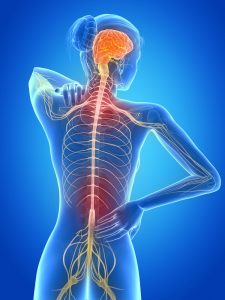Multiple Sclerosis and physical activity
Multiple Sclerosis : definition and symptoms
Multiple Sclerosis (MS) has an annual incidence rate of 4.3 cases per 100 000 in Europe [1]. MS is a disease of the central nervous system affecting brain, spinal cord and optic nerves. The myelin sheath surrounding and protecting the nerve cells and the nerve cells themselves are incorrectly damaged by the immune system, slowing or interrupting the messages between the brain and body. MS symptoms may include visual problems, muscle weakness, fatigue, sensitivity to heat, balance and coordination disorders, cognitive disorders, and sensory modifications (numbness, prickling, “pins and needles”) [2]. There is growing evidence that genetic (female sex) and environmental (smoking, vitamin D deficiency and insufficient sun exposure) factors are associated with MS [3].
The effects of physical activity on Multiple Sclerosis
Through its anti-inflammatory effect, physical activity may slow down the disease process, but it will likely not reverse disease-related impairment. However, exercise will reverse the impairment related to physical inactivity secondary to the disease [4]. Resistance training improves both functional capacity and muscle strength in lower and upper extremities [4, 5]. Also, it has a positive influence on fatigue [5]. Aerobic training results in short-term immune system adaptations but also enhancement in the cardiovascular and neuromuscular systems [4-6]. Increased physical activity is associated with better quality of life in MS patients with enhancement of energy, social functioning, mental and physical health [7]. Aquatic exercise improves also fatigue and quality of life [8]. Balance exercises can reduce the risk of falling [9].
What are the risks?
Generally, exhaustive training should be avoided. In addition, exercise is not recommended during cortisone treatment, which may damage bones, muscles and tendons. The increase in body temperature may aggravate Multiple Sclerosis symptoms. However, this possible worsening of symptoms normalizes half an hour after exercise cessation [10]. In addition, special care should be paid to the peripheral nerves and overstretching should be avoided [5]. To ensure safety, resistance and endurance training should be supervised by an expert.
Recommendations
Physical activity is strongly recommended in the management and evolution of MS [11]. It should be lifelong change. Resistance training increases functional capacity and strength, and should consist of 3-4 sets of 4-8 different exercises at an intensity of 8-15 repetition maximum (i.e. the maximal number of repetitions of a given load that can be lifted with proper technique) on 2-3 days per week. Aerobic exercise (like bicycling ergometry, arm-leg ergometry, arm ergometry, aquatic exercise or treadmill walking) recommendations state 10-40 minutes mild to moderate intensity (60-80% of the maximal heart rate) on 2-3 days per week [4]. 10-15 min of daily stretching to maintain and improve flexibility of muscles and tendons and a 24h recovery time are recommended [5]. In addition, balance and dual task exercises should be initiated at the onset of MS disease. The intensity of the exercises should be increased slowly and not to the point of pain [5].
Related groups
References
- Pugliatti M, Rosati G, Carton H, et al. The epidemiology of multiple sclerosis in Europe. Eur J Neurol 2006;13(7):700-22. Available at: http://dx.doi.org/10.1111/j.1468-1331.2006.01342.x.
- Medlineplus. Multiple sclerosis. 2014 [cited 2014 29/09/2014]; Available from: http://www.nlm.nih.gov/medlineplus/multiplesclerosis.html.
- Kucukali CI, Kurtuncu M, Coban A, Cebi M, Tuzun E. Epigenetics of Multiple Sclerosis: An Updated Review. Neuromolecular Med 2014. Available at: http://dx.doi.org/10.1007/s12017-014-8298-6.
- Dalgas U, Ingemann-Hansen T, Stenager E. Physical Exercise and MS Recommendations. Int MS J 2009;16(1):5-11
- Doring A, Pfueller CF, Paul F, Dorr J. Exercise in multiple sclerosis — an integral component of disease management. EPMA J 2011;3(1):2. Available at: http://dx.doi.org/10.1007/s13167-011-0136-4.
- Bansi J, Bloch W, Gamper U, Riedel S, Kesselring J. Endurance training in MS: short-term immune responses and their relation to cardiorespiratory fitness, health-related quality of life, and fatigue. J Neurol 2013;260(12):2993-3001. Available at: http://dx.doi.org/10.1007/s00415-013-7091-z.
- Marck CH, Hadgkiss EJ, Weiland TJ, Van Der Meer DM, Pereira NG, Jelinek GA. Physical activity and associated levels of disability and quality of life in people with multiple sclerosis: a large international survey. BMC Neurol 2014;14:143. Available at: http://dx.doi.org/10.1186/1471-2377-14-143.
- Kooshiar H, Moshtagh M, Sardar MA, Foroughipour M, Shakeri MT, Vahdati Nia B. Aquatic exercise effect on fatigue and quality of life of women with multiple sclerosis: a randomized controlled clinical trial. J Sports Med Phys Fitness 2014.
- Nilsagard YE, Von Koch LK, Nilsson M, Forsberg AS. Balance exercise program reduced falls in people with multiple sclerosis: a single-group, pretest-posttest trial. Arch Phys Med Rehabil 2014;95(12):2428-34. Available at: http://dx.doi.org/10.1016/j.apmr.2014.06.016.
- Smith RM, Adeney-Steel M, Fulcher G, Longley WA. Symptom change with exercise is a temporary phenomenon for people with multiple sclerosis. Arch Phys Med Rehabil 2006;87(5):723-7. Available at: http://dx.doi.org/10.1016/j.apmr.2006.01.015.
- Rietberg MB, Brooks D, Uitdehaag BM, Kwakkel G. Exercise therapy for multiple sclerosis. Cochrane Database Syst Rev 2005. (1):CD003980. Available at: http://dx.doi.org/10.1002/14651858.CD003980.pub2.
Authors & expert
Authors : Alexis Lion1, Jane S. Thornton2.
Expert : René Metz3.
1 Luxembourg Institute of Health, Sports Medicine Research Laboratory, L-1460 Luxembourg, Luxembourg
2 Centre Hospitalier Universitaire Vaudois, Policlinique Médicale Universitaire, CH-1011 Lausanne, Switzerland
3 Centre Hospitalier de Luxembourg, Service de Neurologie, L-1210 Luxembourg, Luxembourg
Year of publication
2015
